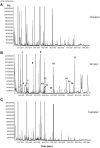Are single odorous components of a predator sufficient to elicit defensive behaviors in prey species?
- PMID: 26283903
- PMCID: PMC4518157
- DOI: 10.3389/fnins.2015.00263
Are single odorous components of a predator sufficient to elicit defensive behaviors in prey species?
Abstract
When exposed to the odor of a sympatric predator, prey animals typically display escape or defensive responses. These phenomena have been well-documented, especially in rodents, when exposed to the odor of a cat, ferret, or fox. As a result of these experiments new discussions center on the following questions: (1) is a single volatile compound such as a major or a minor mixture constituent in urine or feces, emitted by the predator sufficient to cause defensive reactions in a potential prey species or (2) is a whole array of odors required to elicit a response and (3) will the relative size or escapability of the prey as compared to the predator influence responsiveness. Most predator-prey studies on this topic have been performed in the laboratory or under semi-natural conditions. Field studies could help to find answers to these questions. Australian mammals are completely naïve toward the introduced placental carnivores. That offers ideal opportunities to analyze in the field the responses of potential prey species to unknown predator odors. During the last decades researchers have accumulated an enormous amount of data exploring the effects of eutherian predator odors on native marsupial mammals. In this review, we will give a survey about the development of olfactory research, chemical signals and their influence on the behavior and-in some cases-physiology of prey species. In addition, we report on the effects of predator odor experiments performed under natural conditions in Australia. When studying all these literature we learned that data gained under controlled laboratory conditions elucidate the role of individual odors on brain structures and ultimately on a comparatively narrow range behaviors. In contrast to single odors odor arrays mimic much more the situation prey animals are confronted to in nature. Therefore, a broad range of methodology-from chemistry to ecology including anatomy, physiology, and behavior-is needed to understand all the different (relevant) stimuli that govern and guide the interactions between a predator and its potential prey.
Keywords: aging of odors; field studies in Australia; odor avoidance; predator naive prey; predator odors.
Figures


References
-
- Albone E. S., Perry G. C. (1975). Anal sac secretion of the red fox, Vulpes vulpes; volatile fatty acids and diamines: implications for a fermentation hypothesis of chemical recognition. J. Chem. Ecol. 2, 101–111. 10.1007/BF00988029 - DOI
-
- Andersen K. K., Bernstein D. T. (1975). Some chemical constituents of the scent of the striped skunk (Mephitis mephitis). J. Chem. Ecol. 1, 493–499.
-
- Andersen K. K., Bernstein D. T., Caret R. L., Romanczyk L. J., Jr. (1982). Chemical constituents of the defensive secretion of the striped skunk (Mephitis mephitis). Tetrahedron 38, 1965–1970. 10.1016/0040-4020(82)80046-X - DOI
Publication types
LinkOut - more resources
Full Text Sources
Other Literature Sources
Research Materials
Miscellaneous

